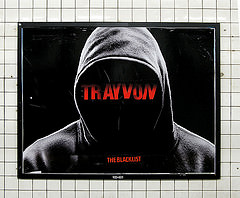I wrote this in 2015 for my patrons. I didn’t publish it then for several reasons. I wanted to let emotions settle so people might be able to hear this better, but there were other reasons I barely remember too. But watching the news of the Amber Guyger trial is making it all too relevant again.
One of the things that disturbed me most in the discussions that followed the terrorist murders of Charlie Hebdo staff early this year was the invocation by atheist activists of fear. It reminded me all too much of the days after thousands lost their lives in the terrorist attacks on September 11, 2001.
I recognize a degree of strangeness to that. The point of a terrorist attack is to create fear in a group of people. It’s unsurprising when this works.
Nor is it surprising that activists would seize on this fear. Fear is an effective motivator, and inertia and indifference are the bane of activists. On top of that, the Charlie Hebdo attack targeted a group of activists who (among other things and using means that we should examine and question, as with any other activists) worked against the political power of Islamists. While not every atheist activist proclaimed, “Je suis Charlie“, it was entirely predictable that many would identify with the targets of the attack.
Still, I was uncomfortable. While I wasn’t as much embedded in the community of the fearful in 2001, it was impossible to miss the consequences of our national fear. In mere weeks and without analysis, we saw law passed that dramatically reduced protections against government surveillance. We were rushed into the Iraq War based on mischaracterized intelligence, a war which arguably increased the danger of radical Islamism rather than decreased it.
In our fear, we made the world a worse place–for ourselves and others. We may even have increased the likelihood of the Charlie Hebdo shootings. It wasn’t our goal, but that doesn’t change what happened.
We’re bad at sitting with fear. When we have any choice, our priority is to “fix” our fear, to make it go away. That may mean avoiding a situation that needs our attention. It may mean acting even when we have only poor-quality choices. What acting out of fear usually doesn’t mean is making good, evidence-based decisions that take the humanity and dignity of other people fully into account.
Sometimes that’s necessary. Fear is, after all, often rational. When it is, we do ourselves no favors by ignoring that fear.
In today’s complex world, however, rational fear can still lead us to make the wrong decisions. Fear of the potential devastation headed our way from global climate change is reasonable, based in scientific consensus. But when we look at the scope of the problem, it becomes overwhelming.
As a society, we aren’t taking even the smaller, manageable steps we could be taking to mitigate the harm of rising sea levels and changing weather patterns. Admittedly, changing energy policy itself may be unachievable in this political climate, but we aren’t tackling the peripheral political problems where we might find a willingness to cooperate either. We are allowing our rational fear to paralyze us.
When we are able to engage despite our fear, it still presents several barriers to humanist decision-making. Acute fear is notorious for this. The “fight-or-flight response” refers to the body’s release of hormones in reaction to perceived danger. While most of us know that extra blood is diverted to the muscles in this reaction, fewer of us know that the hormonal “rush” of fear also has effects on our cognition beyond the distraction of the physical sensation.
Feeling threatened warps the way we think. It heightens our attention to our surroundings, but only to certain parts of it. While experiencing fear, we attend to the negatives in our situations disproportionately to the positives. That is to say, we fill our minds with threats and impediments and ignore support and opportunities.
On top of that, fear leads us to read ambiguity as hostility. If we don’t know that someone is on our side, if we don’t know that they have our best interests at heart, we perceive them as an additional threat.
Needless to say, this has severe negative consequences for our decision-making abilities. We can’t make good decisions when everything looks negative. We can’t take the time we need to sort through evidence and possibilities when everything appears to be threatening us. We can’t spare consideration for others when our own situation appears dire. We can’t opt for solutions we can’t see. We can’t team up with people we think are hostile to solve problems or even for a needed check on our perceptions.
“Fight or flight” is a simplification of our go-to reactions to fear–others include freezing and signalling submission–but none of the reactions facilitated by the hormonal rush of fear are particularly useful for furthering humanist ideals. This is true of longer-term fears as well, not just immediate perceived threats. What we fear looms disproportionately large.
The overall effect of uneasiness with fear appears to be conservatism. Yes, this can mean political conservatism, but it also means a certain consistency of thought. It means a desire for certainty that is at odds both with understanding multiple perspectives on the world and with the shifting landscape of knowledge that the scientific process produces.
Allowing fear to steer our choices will cause us fail to live up to humanist standards. All three humanist manifestos share an emphasis on compassion and naturalism that are at odds with the conservatism engendered by fear. If we want to meet our own ideals, we must set aside the fear of the moment and adopt less reactive frames of mind.
This doesn’t mean we need to set aside our own concerns or to stop listening to what our rational fears tell us, but it does mean we need to work to address these concerns in the light of day. We need to recognize our own fear, deal with it and any immediate threats, yes. Then we need to find ways to de-escalate to the point where we can see solutions and trust collaboration before we deal with longer-term problems that affect more people.
And that’s just rational fear. Far worse is irrational fear.
I don’t mean clinical anxiety, panic disorder, and phobias. While fear that rises to the level of mental illness does, by definition, impair our abilities to make good decisions, people with these disorders tend to know that they’re hindered by fear. They also tend to be the people working hardest to control their fear.
No, what I mean when I talk about the damaging nature of irrational fears is the toll that xenophobia, homophobia, transphobia and the like take on the world. Where rational fear hurts us by impeding progress and hampering empathy, these irrational fears have a far more direct body count.
When we look at someone and see them through the lens of these irrational fears, we don’t see a person. We see a threat to ourselves, even where a societal history of such fears has rendered these people relatively powerless.
Sometimes that threat means ostracism, such as with the real estate redlining that has left many ethnic minorities, but black Americans in particular, living far from economic opportunities and needed services. Sometimes it means criminalization, as when trans women are prohibited from using the bathrooms that best match their gender and in which they are least likely to be subject to violence.
All too often, however, these irrational fears lead directly to violence itself and to the codification of that violence. Stand-your-ground laws were meant to broaden a person’s ability to defend themself when reasonably afraid, but the determination of what is reasonable is left up to legal systems in which these same unreasonable fears are present. This means that, in practice, we have made it legal in some places to kill out of prejudice, and we’ve made very little progress reversing those decisions.
The same problem interferes with our ability to hold our government accountable for inflicting violence upon its citizens. While the federal standard for use of deadly force by law enforcement says that the force must be “objectively reasonable”, further rulings and justice system practices have rendered that term meaningless. In these situations, “objectively” isn’t required to have a basis in reality but merely in an officer’s perception of events. When fear impacts those perceptions such that ambiguity becomes hostility, as discussed above, this means we have made it legal to kill with bias.
We are making some progress toward delegitimizing these fears as a justification for violence, but it’s very recent. Last year, California passed a law forbidding the use of gay and trans panic as a defense against criminal charges for violent acts. It was the first U.S. state to do so. At the time of this writing, it remains the only state.
If we want to succeed in making the world a better place for all of humanity, we need to oppose, not just irrational fears themselves, but also the general acceptance of treating people poorly based on those fears. It isn’t easy work, but it is imperative work, necessary if we’re to achieve our goals.
Fear has its place in human emotion, but as humanists, we must always strive to keep it from dominating our behavior. To do less is to permit bias to rule in the place of empiricism and to allow it to inhibit human flourishing.





Fuck Fear